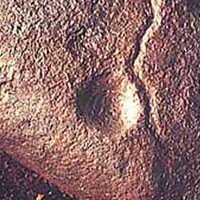-
A period of time marked by Ice Ages and the human development of stone tools. Period lasted from 2,500,000- 230,000 BCE
-
 Earliest example of art. Found in Daraki-Chattan Cave in Central India
Earliest example of art. Found in Daraki-Chattan Cave in Central India -
 Oldest example of the human figure. Discovered in Northern Israel.
Oldest example of the human figure. Discovered in Northern Israel. -
Modern man (homo sapiens) appears in Sub-Sharan African. Lasts from 230,000-40,000 BCE
-
 Crosshatch pattern found on cave walls in South Africa
Crosshatch pattern found on cave walls in South Africa -
Modern man replaces Neanderthal and the last Ice Age occurs. From 40,000-10,000 BCE
-
 First examples of figurative paintings. Pictures show a weasel-like animal. Discovered in France.
First examples of figurative paintings. Pictures show a weasel-like animal. Discovered in France. -
 Oldest and most famous example of Aboriginal art work. Found in Australia.
Oldest and most famous example of Aboriginal art work. Found in Australia. -
 Oldest example of pottery in the world
Oldest example of pottery in the world -
Transitionary time from 10,000-8,000 BCE when the last Ice Age ends and societies change from hunter-gather based to farming.
-
 One of the oldest examples of Native American Art and painting. Found in Oklahoma.
One of the oldest examples of Native American Art and painting. Found in Oklahoma. -
Characterized by farming, domestication of animals and humans creating and using polished stone weapons and fools. Lasts from 8,000 to 3,000 BCE
-
 Discovered in Rio Pinturas, Argentina. A collage of hand stencils that cover most of the inside a the cave.
Discovered in Rio Pinturas, Argentina. A collage of hand stencils that cover most of the inside a the cave. -
Metal weapons and tools are created. Empires, dynasties, and large established societies are found worldwide. Fine arts, written cuneiform and and glass making are developed. 3,200-1,500 BCE
-
 The pyramids of Ancient Egypt begin to be built. This period lasts from 2,650 t0 1,800 BCE
The pyramids of Ancient Egypt begin to be built. This period lasts from 2,650 t0 1,800 BCE -
 Mesopotamian sculpture. One of the finest examples of ancient art. Found in Iraq. Made from gold, copper and lapis lazuli.
Mesopotamian sculpture. One of the finest examples of ancient art. Found in Iraq. Made from gold, copper and lapis lazuli. -
Many great societies rise and fall. Written works, sculptures and pottery are prevalent. The time of Ancient Greece, Rome, Zhou Dynasty and Celtic culture. Period lasts from 1,500-600 BCE
-
 A decorated iron disc found in Ireland
A decorated iron disc found in Ireland -
 The first patterns are found on Greek pottery featuring geometric designs.
The first patterns are found on Greek pottery featuring geometric designs.